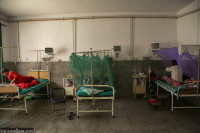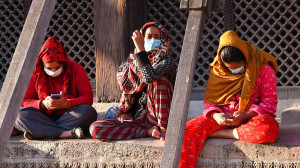Health
Nepal misses malaria elimination goal, new deadline may be 2030
Open border, budget cuts, and mosquitoes moving to higher altitudes due to climate change pose major challenges.
Arjun Poudel
Nepal missed the malaria elimination target, and this is official.
The government had committed to earning the ‘malaria-free’ status in 2026, for that the country needs to bring down indigenous cases or local transmission of the disease to zero, achieve zero deaths from 2023, and sustain zero indigenous cases for three consecutive years.
However, new cases of indigenous malaria have been reported in 2023 and 2024, which shattered all prospects to eliminate the disease from the country.
“It is not possible to eliminate malaria by 2025, as indigenous cases of the deadly disease have been reported in 2023 and 2024,” said Dr Sangeeta Kaushal Mishra, director general of the Department of Health Services. “The new deadline is yet to be set but it could be 2030.”
Malaria is caused by Plasmodium parasites. Infected female Anopheles mosquitoes carry these deadly parasites, according to the World Health Organisation.
Indigenous malaria cases are locally transmitted, in which infected persons do not have a history of travel to malaria-affected countries.
Of the 528 cases of malaria infections reported in the last fiscal year, 23 were indigenous. Of the 505 imported cases, over 80 percent were imported from India.
Some cases of malaria were imported from African countries. Nepali security personnel serving in UN peacekeeping missions in the countries having armed conflicts tested positive for malaria.
Officials say the disease is unlikely to be eliminated in Nepal unless India eliminates it first.
“Due to proximity, and an open and porous border between Nepal and India and unregulated travel of people of both countries, it is impossible to eliminate malaria here in Nepal, until the disease gets eliminated in India,” said Mishra.
Officials say several other factors including cuts in the health budget of government and aid agencies, and shifts in vectors transmitting malaria to the hills and mountains due to global warming also pose serious challenges to meeting the elimination target. Apart from this, most health facilities across the country lack entomologists, which is necessary to carry out surveillance.
“Unlike in the past, when malaria was concentrated in Tarai districts, a large number of cases are now being reported from hill and mountain districts,” said Dr Rudra Marasini, director at the Epidemiology and Disease Control Division.
Malaria has been reported even in the mountain districts of Mugu, Bajura, and Humla, which were considered non-endemic in the past.
“Carrying out surveillance in the hill and mountain districts is more challenging than in Tarai districts,” Marasini said, citing geographical difficulties.
The UN report ‘Climate Change 2022: Impacts, Adaptation and Vulnerability’ states that at least six major vector-borne diseases affected by climate drivers have recently emerged in Nepal and are considered endemic, with climate change implicated as the primary driver.
The report also shows increasing evidence that global warming has extended the elevational distribution of Anopheles, Culex, and Aedes mosquito vectors above 2,000 meters in Nepal.
Malaria-related deaths had stopped since 2016, but five years later, in 2021, the country recorded one death from the disease.
Officials at the health ministry said that until recent years Plasmodium Vivax, a protozoan parasite, was responsible for most of the malaria cases in the country, which causes relatively less severe disease.
However, cases of Plasmodium falciparum, which most often cause severe and life-threatening malaria, have been rising. The parasite is common in many countries in Africa and the Sahara desert.




 13.12°C Kathmandu
13.12°C Kathmandu












%20(1).jpg&w=300&height=200)

